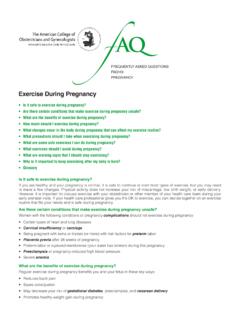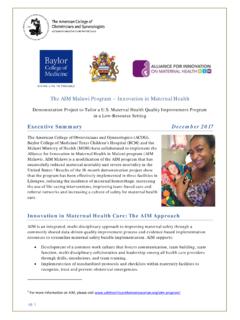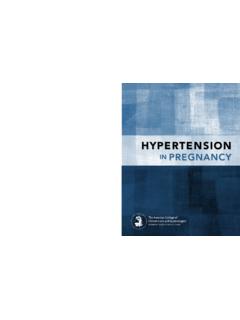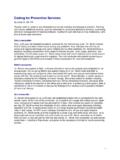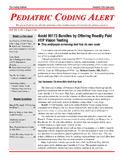Transcription of Coding for Obesity - ACOG
1 ACOG Toolkits for Health Care Providers Coding for Obesity Diagnosis Coding General Correct Coding implies that the code selection is: The most accurate description of what was performed and why it was performed Supported by documentation in the medical record Consistent with Coding conventions and guidelines When selecting ICD-10-CM diagnosis(es) code(s) for an encounter, the diagnosis code(s) must support the clinical need (medical necessity) for the service as described by the Current Proce- dural Terminology (CPT) code linked to the diagnosis.
2 Basic Guidelines for Diagnosis Coding Code to the highest degree of specificity. Code to the highest degree of certainty. Link the diagnosis code to the procedure code (CPT) on the claim. Sequence the diagnoses, reporting the primary diagnosis first, followed by the secondary, etc. Code only diagnoses relevant for the current encounter. Screening for Obesity The ICD-10-CM diagnosis code that may be reported for Obesity screening is (Encounter for screening for other disorder). Treatment A code from code section would be reported for a diagnosis of Obesity .
3 Endocrine, Nutri- tional, and Metabolic Diseases (E00-E89) codes are found in Chapter 4 of ICD-10-CM. The dash - used in this document indicates that an additional character or characters are required for appropriate code selection. Possible ICD-10-CM codes to report linked to the counseling and office visit codes are as follows. Commonly Reported Codes: Code Description Code Obesity (not otherwise specified) Obesity , extreme or morbid Copyright 2016 by the American College of Obstetricians and Gynecologists, 409 12th Street SW, PO Box 96920, Washington, DC 20090-6920.
4 Coding for Obesity 2. Other Obesity Codes Code Description Code Obesity due to excess calories Morbid (severe) Obesity due to excess calories Other Obesity due to excess calories Drug-induced Obesity Morbid (severe) Obesity with alveolar hypoventilation Overweight Other Obesity Obesity , unspecified Body mass index (BMI) (calculated as weight in kilograms divided by height in metrics squared). codes should be reported in addition to the Obesity diagnosis codes, if the BMI value is known. Body Mass Index Codes Body mass index codes are located in Chapter 21 (Factors Influencing Health Status and Contact with Health Services (Z00-Z99)) of ICD-10-CM.
5 A code from code section Z68 would be reported for BMI values. The fourth and fifth characters of ICD-10-CM BMI codes match the BMI number until BMI reaches a value of For example, a BMI of 30 would be reported with code BMI , adult. Body mass index codes would be reported in addition to the selected obe- sity code. Diagnosis codes reported for an obese patient with a BMI of 30 and no other indica- tions would be and Body mass index reporting for BMIs that are greater than 40 is as follows: Code Description Code Morbid Obesity with BMI adult Morbid Obesity with BMI adult Morbid Obesity with BMI adult Morbid Obesity with BMI adult Morbid Obesity with BMI and greater Comorbidities When evaluating a patient for Obesity and you also evaluate comorbidity conditions that you are treating or that affect your treatment, you should report the additional diagnoses codes for those conditions you evaluated that affected this specific visit, linked to the appropriate evaluation and management (CPT) code.
6 Unlike Facility services Coding , where diagnosis-related groups (DRGs). are used to identify related conditions that may affect a patient's care and are tied to reimburse- ment, payment for professional services is tied to CPT procedure codes. In professional services Coding , although diagnosis codes are not tied directly to provider reim- bursement, they do support the medical necessity for performing specific services when linked to Coding for Obesity 3. CPT procedure codes. Reimbursement will be based on the key components (history, examina- tion, and medical-decision-making) of the problem-oriented Evaluation and Management (E/M).
7 Service or the appropriate screening code. Alternatively, you may report a problem oriented E/M. service if more than 50% of total time was spent counseling the patient. See the detailed discus- sion on time-based procedure Coding below. Documentation should reflect the level and intensity of the key components, or time of the total service provided. Please note that even when mul- tiple diagnosis codes are reported, some payer edit software targets only the primary diagnosis code for the visit. As a result, you should always sequence the primary diagnosis code (ie, primary reason for the visit) for the visit, as the first linked diagnosis.
8 Comorbidities affecting the patient's Obesity assessment, evaluation, or treatment that also are evaluated would be reported as second- ary codes. (See the Obesity Comorbidities Coding Chart.). Screening Encounter for screening for diabetes mellitus Encounter for screening for nutritional, metabolic & other endocrine disorders Encounter for screening for nutritional disorder Encounter for screening for metabolic disorder Encounter for screening for lipoid disorders Encounter for screening for other metabolic disorders Encounter for screening for other suspected endocrine disorder(includes screening for thyroid disorder).
9 Counseling Dietary counseling and surveillance Other specified counseling - Exercise counseling Procedure Coding The most appropriate E/M code to select will depend on whether the encounter was for screening or treatment of Obesity . If the encounter was for screening the patient, report a preventive medicine code from code section 99401-99412. These codes are selected according to the time spent in face-to-face coun- seling with the patient. Whether or not these codes will be reimbursed by the payer will vary. Possible procedure codes are: Code Description Code Preventive medicine, individual counseling 99401-99404 Preventive medicine, group counseling 99411-99412 Coding for Obesity 4.
10 If the encounter was for treatment for a patient with a diagnosis of Obesity , report an office or other outpatient E/M code. These codes list a typical time in the code descriptions. Codes with typical times listed may be reported based on time, rather than the key E/M components of;. history, exam, and medical-decision-making. If the health care provider spends more that 50% of the visit counseling the patient, the E/M code may be selected based on time. Time spent pro- viding face-to-face counseling with the patient must be documented in the medical record.
